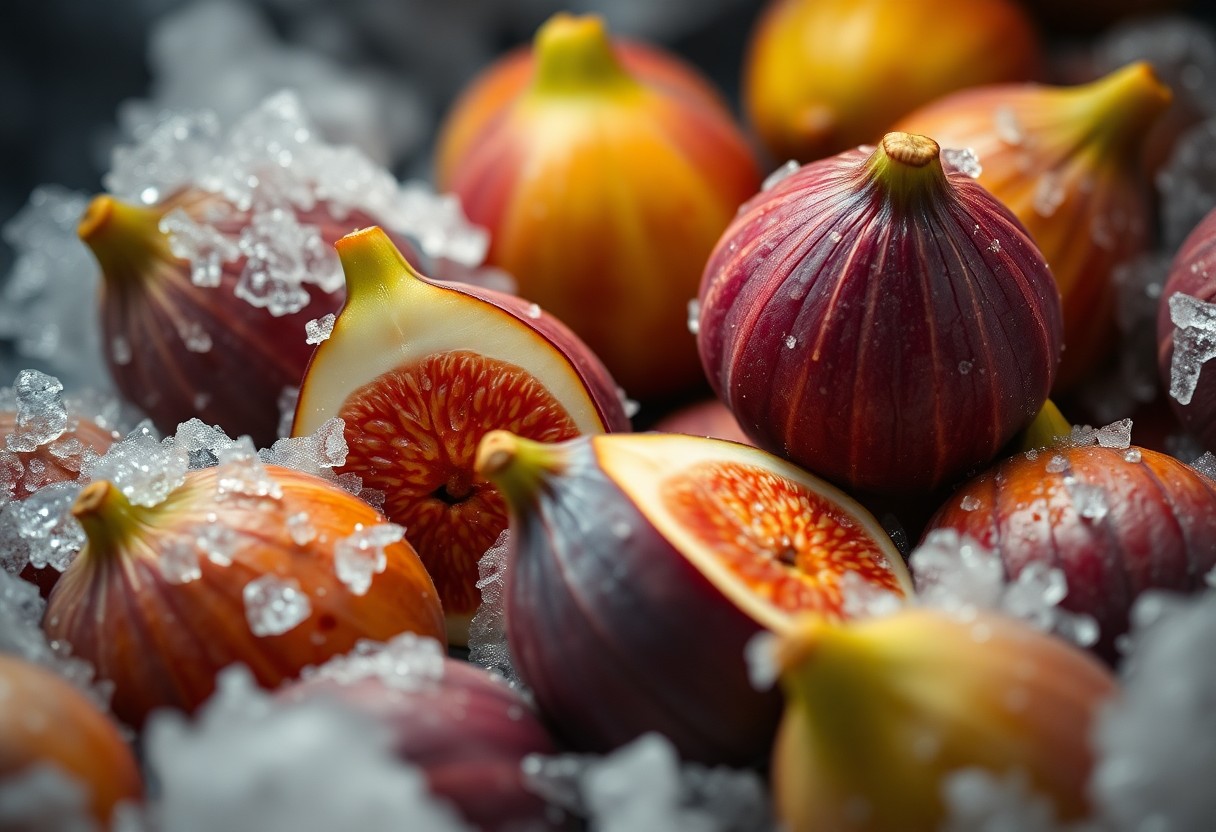As you consider preserving your fresh figs, you might wonder if freezing is an option. You can enjoy your figs year-round by storing them properly. Freezing is a great way to maintain your figs’ flavor and texture, but you need to do it correctly. Your fresh figs can be frozen, and with the right method, you’ll be able to savor them in various dishes throughout the year.

Benefits of Freezing Figs
To enjoy figs year-round, freezing is a great option. You can preserve your favorite fruit and use it in various recipes, from baked goods to savory dishes. Freezing figs helps retain their nutritional value and flavor, making them a great addition to your meals.
Preserving Nutrients
Prior to freezing, you should know that this method helps preserve the nutrients in figs. You can enjoy your frozen figs with minimal loss of vitamins and minerals, making them a healthy choice for your diet.
Extending Shelf Life
Between the time you purchase figs and the time you use them, freezing can extend their shelf life significantly. You can store frozen figs for several months, allowing you to enjoy them at your convenience.
Another advantage of freezing figs is that it allows you to buy in bulk and store them for later use. You can use your frozen figs in smoothies, baked goods, or as a topping for yogurt or oatmeal, giving you flexibility in your meal planning and preparation.
Preparation for Freezing
Some preparation is necessary before you can freeze your figs, and it’s imperative to get it right to preserve their flavor and texture.
Selecting the Right Figs
To choose the best figs for freezing, you should pick those that are ripe but still firm, as they will hold their shape and flavor better during the freezing process.
Cleaning and Drying
On the day you plan to freeze your figs, you’ll need to clean them gently to remove any dirt or debris, and then dry them thoroughly to prevent ice crystals from forming.
The drying process is particularly important, as excess moisture can cause your figs to become icy or develop off-flavors when frozen, so you should pat them dry with a paper towel or clean cloth to remove as much moisture as possible before placing them in the freezer.
Freezing Methods
Even if you’re new to freezing fruits, you’ll find that preserving figs is a straightforward process. You can freeze them whole, sliced, or as a jam/puree, depending on your intended use. This flexibility allows you to enjoy figs year-round, incorporating them into various recipes as needed.
Whole Figs
Methods for freezing whole figs involve gently washing and drying the fruit before placing it in airtight containers or freezer bags. You can then store these in your freezer, making it easy to grab a few whenever you need them for your favorite recipes.
Fig Jam or Puree
After preparing your figs, you can cook them down into a jam or puree, which is ideal for spreading on toast, using in baking, or as a topping for yogurt or ice cream. You’ll find that this form is especially convenient for recipes where you want the flavor and texture of figs without the whole fruit.
Understanding the process of making fig jam or puree is key to enjoying your frozen figs. You will appreciate the ability to use your frozen figs in a variety of dishes, from sweet treats like cakes and cookies to savory dishes like salads and stews, by having them preserved in this versatile form.

Storage and Thawing
For optimal preservation, you should consider the proper storage and thawing methods for your frozen figs.
Freezer Storage Tips
You can store frozen figs in airtight containers or freezer bags, with the following tips:
- Label and date the containers
- Store at 0°F (-18°C)
The frozen figs will retain their quality for several months.
Thawing and Using Frozen Figs
Among the various methods, you can thaw frozen figs by leaving them in room temperature or by refrigerating them overnight.
Understanding the best thawing method will help you use your frozen figs in various recipes, such as jams, smoothies, or baked goods, and you will be able to enjoy your frozen figs throughout the year, as you can thaw and use them as needed, making the most of your harvest.
Recipes Using Frozen Figs
Keep in mind that frozen figs can be used in a variety of dishes, and you can find inspiration online, such as on Got about 3000+ figs that are all about to drop at about the same time, to get the most out of your frozen figs.
Baked Goods
Freshly baked goods like cakes, muffins, and scones can be made using frozen figs, allowing you to enjoy your favorite treats year-round with your stored figs.
Desserts and Smoothies
Frozen figs can be used to make delicious desserts and smoothies, and you can experiment with different combinations to find your favorite flavors, such as pairing figs with yogurt or honey.
Due to the sweet and jam-like texture of frozen figs, you can use them as a topping for your favorite desserts, such as ice cream or oatmeal, and also blend them into your smoothies for a boost of nutrition and flavor, making your meals more enjoyable and healthy.
Common Mistakes to Avoid
Unlike other fruits, figs require special care when freezing, and you should be aware of the potential pitfalls to ensure the best results.
Incorrect Freezing Techniques
Any attempt to freeze figs without proper preparation can lead to undesirable texture and flavor changes, so you should follow a tried-and-tested method to preserve your figs effectively.
Improper Storage
About the storage of frozen figs, you should know that using the wrong containers or bags can cause freezer burn and affect the quality of your figs.
Avoid exposing your frozen figs to air, moisture, or light, as this can cause them to deteriorate quickly, and make sure you store them in airtight, freezer-safe containers or bags to maintain their freshness and flavor.
Final Words
With these considerations, you can confidently preserve your figs by freezing them. You should now be aware of the proper methods to freeze figs, allowing you to enjoy your favorite fruit year-round. By following these steps, you can maintain your figs’ quality and texture, ensuring your frozen figs are perfect for your desired recipes, and you can make the most of your harvest or purchase.
FAQ
Q: Can you freeze fresh figs to enjoy them throughout the year?
A: Yes, you can freeze fresh figs to preserve them for a longer period. Fresh figs are highly perishable and have a short shelf life, but freezing helps retain their flavor and nutritional value. To freeze them, first, clean and dry the figs, then place them in a single layer on a baking sheet and put it in the freezer. Once they are frozen, transfer them to an airtight container or freezer bag for storage. Frozen figs are perfect for adding to baked goods, smoothies, or as a topping for yogurt or oatmeal.
Q: How do you properly prepare figs for freezing to maintain their quality and taste?
A: Preparing figs for freezing involves a few steps to ensure they maintain their quality and taste. Start by gently washing the figs in cold water, then pat them dry with a paper towel to remove excess moisture. You can freeze them whole, sliced, or chopped, depending on your intended use. For whole figs, you might want to pack them in a sugar syrup (equal parts sugar and water, dissolved) before freezing to help preserve their texture and flavor. If you prefer to freeze them without added sugar, place them in a single layer on a baking sheet, freeze, and then transfer them to airtight containers or freezer bags, making sure to press out as much air as possible before sealing to prevent freezer burn.
Q: Can you thaw and refreeze figs, and what are the best ways to use frozen figs in cooking and baking?
A: It’s generally not advisable to thaw and refreeze figs as this can lead to a significant loss of quality, causing them to become mushy and less flavorful. Once frozen, it’s best to use them directly from the frozen state in your recipes. Frozen figs are versatile and can be used in a variety of dishes. They add natural sweetness and texture to baked goods like cakes, muffins, and bread. You can also blend them into smoothies, use them as a topping for ice cream, yogurt, or salads, or even make jam by blending them with alittle water and sugar, then simmering the mixture until it thickens. For savory dishes, figs can complement cheeses, meats, and crackers, offering a sweet and savory combination that’s perfect for appetizers or snacks.





Leave a Reply